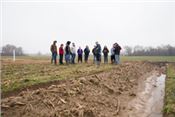|
Southeast’s Subsurface Drainage And Irrigation System Increases Water And Soil Health

Southeast students and Dr. Mike Aide survey the paddy levee
system on a 100-acre field at the David M. Barton Agriculture Research Center.
CAPE GIRARDEAU, MO.
The Southeast Missouri State University Department of Agriculture’s subsurface drainage and irrigation system has seen positive results for reducing nitrate concentrations and promoting water and soil health during the first growing season with it in place.
The large-soil project is part of a pilot program with the U.S. Department of Agriculture-Agriculture Research Service (USDA-ARS) to pump nutrient impacted water from Williams Creek in Cape Girardeau, Missouri, onto fields, cleanse the drained water and return it to the creek.
Nitrates in water sources such as creeks and aquifers are an emerging health issue for the nation and especially in the Midwest, said Dr. Mike Aide, chair of Southeast’s Department of Agriculture.
“Nitrates are a result of natural and fertilization processes,” said Aide. “If they leach below the crop rooting system into an aquifer, that is a form of pollution to our drinking water.”
The legal limit for nitrates is 10 parts per million (nitrate-N), after which premature births can occur in animals and humans who consume the polluted water, said Aide.
Students recently constructed a paddy levee system on a 100-acre field at the David M. Barton Agriculture Research Center, similar to a rice paddy. There, water is pumped from Williams Creek onto the field. Water that isn’t absorbed by the plants leaches through soil and into the subsurface drainage system where it is directed to an underground denitrification bioreactor. The 32-by-65-foot bioreactor, a USDA-ARS design, is packed with two-inch wood chips and filters nitrates accumulated from the creek and soil.
“The water permeates through the woodchips, and the bacteria on the woodchips converts the nitrates to nitrogen gas which is 78 percent of the atmosphere,” said Aide. “We reduced it from a harmful chemical to an inert form.”
The cleansed water is then returned to Williams Creek.
The 2015 growing season was the first operational year for the denitrification bioreactor. From April to July, students measured the nitrate concentrations entering and exiting the bioreactor. The results show a significant decrease in the nitrates of the water returning to the creek and local aquifer.
The project’s results have huge implications for further developments and applying the system in the Midwest and South. Even institutes as far as California, where drought and water issues are prevalent, have inquired about their data, said Aide.
Having students involved allows tomorrow’s agriculture leaders to help develop, learn and implement their own ideas and technologies, said Aide.
“Having the hands-on experience gives us the background to help find solutions in the future,” said Lauren Casebolt, an agricultural industry major from Scott City. “Right now high levels of nitrates in our water are harmful to plants, animals and humans, and it’s pretty cool we can take the water from the creek and return it cleaner than what it started as.”
Martin Aide, an agribusiness major, says more and more farming communities will be using systems like Southeast’s bioreactor in the near future.
“I think it’ll be mainstream because it does work and it works really well,” said Martin.
Martin has studied the impact of nitrates entering the Gulf of Mexico and how they’re becoming not just a global issue but a local problem.
“It could become a government regulated issue, but we have a head start,” said Martin.
The department begins its second round of irrigation this month through December and will continue to calculate and compile readings. ∆
|
|